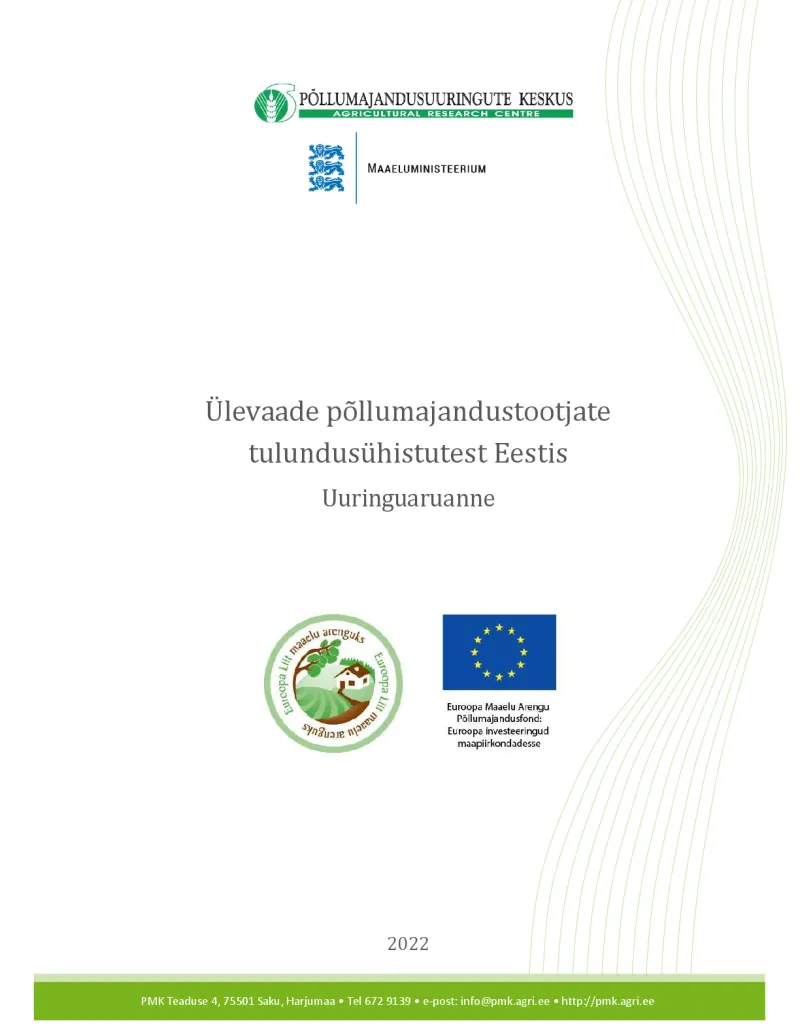Overview of agricultural cooperatives in Estonia
- Evaluation
- Food Supply Chain
- Jobs, Growth and Equality in Rural Areas
- Agricultural Productivity
- Evaluation
The study aims to provide an overview of agricultural cooperatives operating in Estonia.
- Estonia
- Programming period: 2014-2022
- Socio-economic impacts


In the 2023–2027 CAP Strategic Plan, one Specific Objective (SO) is to support cooperative activities - SO3: Improve the farmers' position in the value chain. In addition, in the Estonian sectoral strategy for agriculture and fisheries until 2030, one of the objectives is to strengthen producers' positions through cooperative activities.
The aim of the study is to update the overview of agricultural cooperatives operating in Estonia to provide input for elaborating the conditions for support provided by interventions in the CAP Strategic Plan. It will also support better budget planning and help find indicators for the Estonian Agriculture and Fisheries Strategy 2030.
The study provides an overview of the structure of agricultural cooperatives operating in Estonia, including information about cooperatives' members and economic performance as of the end of 2020. Additionally, it compares the data from 2020 with the data collected by the Estonian University of Life Sciences in 2018 and analyses the changes that have occurred, where possible.
The methodological approach involved surveys, interviews, and qualitative and quantitative approaches.
The main data sources were the Centre of Registers and Information Systems (administrative data - the number of registered agricultural cooperatives active agricultural cooperatives' annual reports - and statutes as of the end of 2020) and Agricultural Research Centre (primary data - survey questionnaires and interviews conducted according to the sample and the objectives of the study.).
All business entities engaged in agricultural activities and registered in the commercial register as of the end of 2020, with the legal form of a cooperative (i.e. agricultural cooperatives) and conducted economic activities according to their annual reports, were included in the study sample.
Various quantitative and qualitative indicators were analysed to provide an overview of the cooperatives and to compare data with 2018 (previous study).
Some limitations occurred in data collection when the initial planned deadline for the survey was extended several times due to low response activity. Multiple reminders were sent to encourage responses from the agricultural cooperatives included in the sample.
The study concludes that support directed to producer groups under the Rural Development Programme (RDP) had a positive impact on producers' joining cooperatives. By the end of 2020, 35% of economically active agricultural cooperatives were established during the 2014–2020 RDP period.
In the CAP Strategic Plan, the subsidies for cooperative activities are directed towards establishing and developing recognised Producer Organisations. Establishing a recognised Producer Organisation enables access to investment measures aimed at cooperative activities. One of the requirements for recognition as a Producer Organisation is that the cooperative must have a minimum of 10 independent members. The study revealed that as of the end of 2020, 71% of economically active cooperatives did not meet the requirements for the number of members to be recognised, as the majority of active cooperatives are small, with up to five members.
Another important requirement for recognition as a Producer Organisation is the sector-specific three-year average turnover (if the cooperative has been operating for less time, the average turnover considered is the previous financial year or two years).
When analysing cooperatives' turnover in 2020 according to the revenue requirements for recognition, it was found that only 12% of active cooperatives meet the revenue requirements set for sector-specific revenue.
Author(s)
Agnes Naarits, Kristine Tiirats, Eduard Matveev, Marju Aamisepp (METK - Centre of Estonian Rural Research and Knowledge)